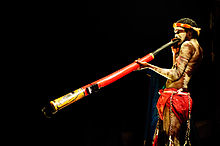
A, B and C: Three didgeridoos that were crafted and decorated by traditional custodians of the instrument
D: Typical non-traditional Aboriginal didgeridoo made for tourist trade with non-traditional decorations E: A didgeridoo made by non-Aboriginals in Australia, not decorated | |
| Brass instrument | |
|---|---|
| Classification | |
| Hornbostel–Sachs classification | (Aerophone sounded by lip movement) |
| Playing range | |
| Written range: | |
| Related instruments | |
| Trumpet, Flugelhorn, Cornet, Bugle, Natural trumpet, Post horn, Roman tuba, Bucina, Shofar, Conch, Lur, Baritone horn, Bronze Age Irish Horn | |
The didgeridoo (/ˌdɪdʒəriːˈduː/) (also known as a didjeridu) is a wind instrument developed by Indigenous Australians of northern Australia potentially within the last 1,500 years and still in widespread use today both in Australia and around the world. It is sometimes described as a natural wooden trumpet or "drone pipe". Musicologists classify it as a brass aerophone.[1]
There are no reliable sources stating the didgeridoo's exact age. Archaeological studies of rock art in Northern Australia suggest that the people of the Kakadu region of the Northern Territory have been using the didgeridoo for less than 1,000 years, based on the dating of paintings on cave walls and shelters from this period.[2] A clear rock painting in Ginga Wardelirrhmeng, on the northern edge of the Arnhem Land plateau, from the freshwater period[3] (that had begun 1500 years ago)[4] shows a didgeridoo player and two songmen participating in an Ubarr Ceremony.[5]
A modern didgeridoo is usually cylindrical or conical, and can measure anywhere from 1 to 3 m (3 to 10 ft) long. Most are around 1.2 m (4 ft) long. Generally, the longer the instrument, the lower its pitch or key. However, flared instruments play a higher pitch than unflared instruments of the same length.
Names and etymology
There are numerous names for the instrument among the Aboriginal peoples of northern Australia, none of which closely resemble the word "didgeridoo" (see below). Many didgeridoo enthusiasts and some scholars advocate reserving local names for traditional instruments, and this practice has been endorsed by some Aboriginal community organisations.[6] However, in everyday conversation, bilingual Aboriginal people will often use the word "didgeridoo" interchangeably with the instrument's name in their own language.
"Didgeridoo" is considered to be an onomatopoetic word of Western invention. The earliest occurrences of the word in print include a 1908 edition of the Hamilton Spectator,[7] a 1914 edition of The Northern Territory Times and Gazette,[8] and a 1919 issue of Smith's Weekly where it was referred to as an "infernal didjerry" which "produced but one sound – (phonic) didjerry, didjerry, didjerry and so on ad infinitum".[9]
A rival explanation, that didgeridoo is a corruption of the Irish language (Gaelic) phrase dúdaire dubh or dúidire dúth, is controversial.[10]Dúdaire/dúidire is a noun that may mean, depending on the context, "trumpeter", "hummer", "crooner", "long-necked person", "puffer", "eavesdropper", or "chain smoker", while dubh means "black" and dúth means "native".
Yiḏaki (sometimes spelt yirdaki) is one of the most commonly used names, although – strictly speaking – it refers to a specific type of instrument made and used by the Yolngu people of north-east Arnhem Land. However, since the passing, in early 2011, of a Manggalili-clan man whose name sounds similar to yiḏaki, Yolngu themselves now use the synonym mandapul to refer to the instrument, out of respect for the deceased.
There are numerous other, regional names for the didgeridoo. The following are some of the more common of these.[11]
See also: Modern didgeridoo designsConstruction
Authentic Aboriginal didgeridoos are produced in traditionally oriented communities in Northern Australia or by makers who travel to Central and Northern Australia to collect the raw materials. They are usually made from hardwoods, especially the various eucalyptus species that are endemic to the region.[12] Generally the main trunk of the tree is harvested, though a substantial branch may be used instead. Aboriginal didgeridoo craftsmen hunt for suitably hollow live trees in areas with obvious termite activity. Termites attack these living eucalyptus trees, removing only the dead heartwood of the tree, as the living sapwood contains a chemical that repels the insects.[13] Various techniques are employed to find trees with a suitable hollow, including knowledge of landscape and termite activity patterns, and a kind of tap or knock test, in which the bark of the tree is peeled back, and a fingernail or the blunt end of a tool, such as an axe is knocked against the wood to determine if the hollow produces the right resonance.[14]
Once a suitably hollow tree is found, it is cut down and cleaned out, the bark is taken off, the ends trimmed, and the exterior is shaped; this results in a finished instrument. This instrument may be painted or left undecorated. A rim of beeswax may be applied to the mouthpiece end. Traditional instruments made by Aboriginal craftsmen in Arnhem Land are sometimes fitted with a "sugarbag" mouthpiece. This black beeswax comes from wild bees and has a distinctive aroma.
Non-traditional didgeridoos can also be made from PVC piping, non-native hard woods (typically split, hollowed and rejoined), glass, fiberglass, metal, agave, clay, hemp (in the form of a bioplastic named zelfo), and even carbon fibre. These didges typically have an upper inside diameter of around 1.25" down to a bell end of anywhere between two and eight inches and have a length corresponding to the desired key. The mouthpiece can be constructed of beeswax, hardwood or simply sanded and sized by the craftsman. In PVC, an appropriately sized rubber stopper with a hole cut into it is equally acceptable, or to finely sand and buff the end of the pipe to create a comfortable mouthpiece.
Modern didgeridoo designs are distinct from the traditional Australian Aboriginal didgeridoo, and are innovations recognized by musicologists.[15][16] Didgeridoo design innovation started in the late 20th century using non-traditional materials and non-traditional shapes.
Decoration
Many didgeridoos are painted using traditional or modern paints by either their maker or a dedicated artist, however it is not essential that the instrument be decorated. It is also common to retain the natural wood grain with minimal or no decoration. Some modern makers deliberately avoid decoration if they are not of Indigenous Australian descent, or leave the instrument blank for an Indigenous Australian artist to decorate it at a later stage.
Playing the didgeridoo
The didgeridoo is played with continuously vibrating lips to produce the drone while using a special breathing technique called circular breathing. This requires breathing in through the nose whilst simultaneously expelling stored air out of the mouth using the tongue and cheeks. By use of this technique, a skilled player can replenish the air in their lungs, and with practice can sustain a note for as long as desired. Recordings exist of modern didgeridoo players playing continuously for more than 40 minutes; Mark Atkins on Didgeridoo Concerto (1994) plays for over 50 minutes continuously.






No comments:
Post a Comment